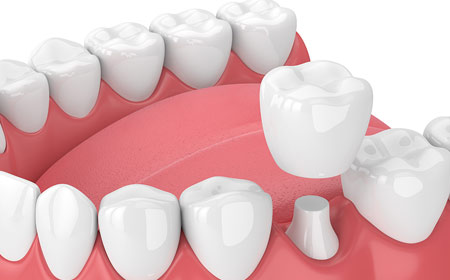The process is somewhere between a filling and a crown. The tooth is prepared just like a filling (although the design might need to be a bit different), however rather than building the filling up directly in the tooth, the prepared site is copied (either with a digital scan or an impression), and then the restoration is prepared in a lab. Once it is ready to go, the tooth is disinfected and cleaned, and the restoration is glued in place.
Crowns
A crown is a protective cover that goes over a tooth to provide strength and protection beyond what a filling or onlay is capable of. You can think of a dental crown on a tooth in some ways like a hat or your head. It not only sits over the top, but all the way around the sides as well. Crowns are made of very strong materials and they wrap all the way around the tooth holding it all together, which provides great protection for a tooth that is compromised. Because they are made outside of the mouth, they are manufactured to fit perfectly but passively onto the prepared tooth, which when glued on, provides mechanical protection of the tooth, a very good seal against bacteria, and greater longevity than large direct fillings.
The process of having a crown involves 4 steps:
- The tooth is prepared. The design usually involved firstly building up a core if there is tooth missing on the inside, and then removing a thin layer around the tooth. This provides space for the crown so that it can sit on the tooth without interfering with the bite.
- The preparation is copied. Once the tooth is prepared, we need to take a copy of the prepared surface. This is either done with a very accurate impression or a digital scan. Depending on how long it takes to make the replacement tooth, a temporary crown might be made to cover the tooth in the interim.
- Once we have a copy of the prepared tooth, we can design and manufacture the crown. We can choose the type of material and colour that we want and then it is manufactured in a lab.
- The crown is inserted or glued into the mouth. Once the crown has been designed and manufactured, it is ready to be glued onto the prepared tooth. The dentist will ensure that everything fits well, and then after disinfecting and cleaning both the crown and the tooth, they are glued together. The bond between the crown and the tooth is very strong and is unlikely to ever come apart.
Bridge
A bridge is a way of replacing a missing tooth. A conventional bridge involves essentially 2 crowns either side of a gap, that are joined together with a fake tooth that replaces the missing tooth. The process of a bridge is pretty much exactly the same as a crown, except you are doing 2 at the same time.
Bridges used to be the gold standard of replacing a missing tooth, however as dental implant technology has improved and the price has come down, this has really shifted to dental implants. In situations where an implant is not possible or contraindicated, a bridge is still a good way to replace a tooth, and will feel a lot like natural teeth in terms of feel and function. It is important that they are well maintained as a compromised bridge can affect both of the teeth that it is supported on.
Veneers
See Veneers in Aesthetic treatment.
If you suspect you might need an indirect filling, a crown, or a bridge, or would like more information, please don’t hesitate to give us a call on (07) 3379 1328

